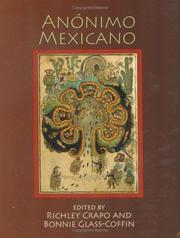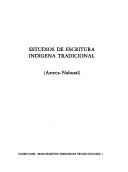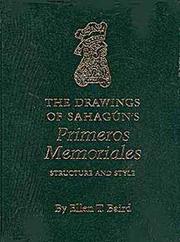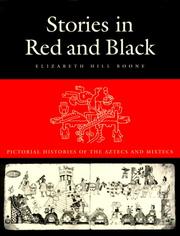| Listing 1 - 10 of 11 | << page >> |
Sort by
|

ISBN: 1283267241 9786613267245 0874215153 0874216230 9780874215151 9780874216233 9781283267243 Year: 2005 Publisher: Logan, UT : Utah State University Press,
Abstract | Keywords | Export | Availability | Bookmark
 Loading...
Loading...Choose an application
- Reference Manager
- EndNote
- RefWorks (Direct export to RefWorks)
Anonimo Mexicano is the first publication of the full Nahuatl text and English translation of a rare and important Native history of preconquest Mexico. Written circa 1600 by an anonymous Tlaxcaltecan author, it is an epic account of the settling of central Mexico by Nahua peoples from the northern frontier. They developed a sophisticated culture with powerful city states and an agricultural economy, fought great wars, established dynasties, and recorded their history and legends in painted books. The Mexica became the most powerful of these nations until their conquest by the Spanish w
Indians of Mexico. --- Manuscripts, Nahuatl. --- Manuscripts, Nahuatl - Mexico - Tlaxcala (State). --- Tlaxcala (Mexico: State) - History. --- Tlaxcalan Indians. --- Tlaxcalan Indians - History. --- Tlaxcalan Indians - Migrations. --- Tlaxcalan Indians - Origin. --- Earth & Environmental Sciences --- Environmental Sciences --- Tlaxcalan Indians --- Manuscripts, Nahuatl --- Origin. --- History. --- Migrations. --- Tlaxcala (Mexico : State) --- History --- Manuscripts, Aztec --- Nahuatl manuscripts --- Tlascala Indians --- Tlascalan Indians --- Tlaxcaltecan Indians --- Indians of Mexico --- Indians of North America --- Indigenous peoples --- Meso-America --- Meso-American Indians --- Mesoamerica --- Mesoamerican Indians --- Pre-Columbian Indians --- Precolumbian Indians --- Ethnology --- Gobierno del Estado Libre y Soberano de Tlaxcala (Mexico) --- Gobierno del Estado de Tlaxcala (Mexico) --- Estado de Tlaxcala (Mexico) --- Tlaxcallān (Mexico : State) --- Free and Sovereign State of Tlaxcala (Mexico) --- Estado Libre y Soberano de Tlaxcala (Mexico) --- State of Tlaxcala (Mexico)

ISBN: 968805044X 9791036540134 Year: 2019 Volume: 1 Publisher: Mexico : Centro de estudios mexicanos y centroamericanos,
Abstract | Keywords | Export | Availability | Bookmark
 Loading...
Loading...Choose an application
- Reference Manager
- EndNote
- RefWorks (Direct export to RefWorks)
Nahuatl language --- Indians of Mexico --- Aztèques --- Langues indiennes d'Amérique --- Writing. --- Languages --- Writing --- Ecriture --- Aztec hieroglyphics --- Aztecs --- Hieroglyphics, Aztec --- Picture-writing, Aztec --- Tlaxcalan Indians --- náhuatl --- escritura --- lingüística --- codex
Book
ISBN: 9791036540066 9686029664 Year: 2019 Publisher: Mexico : Centro de estudios mexicanos y centroamericanos,
Abstract | Keywords | Export | Availability | Bookmark
 Loading...
Loading...Choose an application
- Reference Manager
- EndNote
- RefWorks (Direct export to RefWorks)
Cet ouvrage est une contribution à l'étude des pictographies aztèques considérées non seulement dans leur rôle de symboles, mais aussi en tant que composantes d'un système d'écriture, progressivement déchiffré par des équipes mexicaines et françaises dans les deux pays, l'impulsion originelle ayant été donnée par M. Joaquin Galarza. Le livre, abondamment illustré, analyse de façon exhaustive la représentation de la divinité Xipe Totec, et celle de trois de ses rituels les plus importants : l'écorchement, le sacrifice dit « du gladiateur » et celui dit « des flèches ». L'auteur présente en annexe les sources du xvie siècle contenant des références à cette divinité, ainsi qu'un glossaire de termes nahuatl. Il évoque en guise d'épilogue des rituels analogues qui se manifestent dans l'Amérique précolombienne.
Xipe Totec (Aztec deity) --- Nahuatl language --- Writing. --- Aztec hieroglyphics --- Aztecs --- Hieroglyphics, Aztec --- Picture-writing, Aztec --- Tlaxcalan Indians --- Flayed God (Aztec deity) --- Aztec gods --- Writing --- pictographie --- glyphe --- Xipe Totec --- rituel --- spiritualité
Book
ISBN: 9789004391451 9004391452 9789004392014 9004392017 Year: 2019 Publisher: Leiden Boston
Abstract | Keywords | Export | Availability | Bookmark
 Loading...
Loading...Choose an application
- Reference Manager
- EndNote
- RefWorks (Direct export to RefWorks)
"In her groundbreaking investigation from the perspective of the aesthetics of religion, Isabel Laack explores the religion and art of writing of the pre-Hispanic Aztecs of Mexico. Inspired by postcolonial approaches, she reveals Eurocentric biases in academic representations of Aztec cosmovision, ontology, epistemology, ritual, aesthetics, and the writing system to provide a powerful interpretation of the Nahua sense of reality.0Laack transcends the concept of "sacred scripture" traditionally employed in religions studies in order to reconstruct the Indigenous semiotic theory and to reveal how Aztec pictography can express complex aspects of embodied meaning. Her study offers an innovative approach to nonphonographic semiotic systems, as created in many world cultures, and expands our understanding of human recorded visual communication. 0This book will be essential reading for scholars and readers interested in the history of religions, Mesoamerican studies, and the ancient civilizations of the Americas." Source : cover
Nahuatl language --- Nahuas --- Aztec cosmology. --- Writing. --- Religion. --- Aztecs --- Aztec cosmology --- 299.77 --- Cosmology, Aztec --- Cosmology --- Aztec hieroglyphics --- Hieroglyphics, Aztec --- Picture-writing, Aztec --- Tlaxcalan Indians --- 299.77 Godsdiensten van de Middenamerikaanse Indianen: Mexicanen; Azteken; Tolteken; Tzapoteken; Maya's --- Godsdiensten van de Middenamerikaanse Indianen: Mexicanen; Azteken; Tolteken; Tzapoteken; Maya's --- Writing --- Religion
Book
ISBN: 8485229991 Year: 1986 Volume: 26 Publisher: Madrid : Historia 16,
Abstract | Keywords | Export | Availability | Bookmark
 Loading...
Loading...Choose an application
- Reference Manager
- EndNote
- RefWorks (Direct export to RefWorks)
Tlaxcalan Indians --- Indians of Mexico --- Tlaxcaltèques --- Indiens d'Amérique --- History --- Histoire --- Tlaxcala (Mexico : State) --- Tlaxcala de Xicohtencatl (Mexico) --- Mexico --- Mexique --- -Tlaxcalan Indians --- -Tlascala Indians --- Tlascalan Indians --- Tlaxcaltecan Indians --- Indians of North America --- Indigenous peoples --- Meso-America --- Meso-American Indians --- Mesoamerica --- Mesoamerican Indians --- Pre-Columbian Indians --- Precolumbian Indians --- Ethnology --- -Tlaxcala de Xicohtencatl (Mexico) --- -History --- History. --- Tlaxcaltèques --- Indiens d'Amérique --- -Tlaxcala, Mexico (City) --- Tlaxcala (Tlaxcala, Mexico) --- Tlaxcallān Xīcohtēncatl (Mexico) --- Tlaxcallān (Tlaxcala, Mexico) --- Gobierno del Estado Libre y Soberano de Tlaxcala (Mexico) --- Gobierno del Estado de Tlaxcala (Mexico) --- Estado de Tlaxcala (Mexico) --- Tlaxcallān (Mexico : State) --- Free and Sovereign State of Tlaxcala (Mexico) --- Estado Libre y Soberano de Tlaxcala (Mexico) --- State of Tlaxcala (Mexico) --- Meksiko --- Stany Zjednoczone Meksyku --- Meksyk --- Estados Unidos Mexicanos --- Meḳsiḳe --- Mexique (Country) --- Messico --- Méjico --- República Mexicana --- United States of Mexico --- United Mexican States --- Anáhuac --- メキシコ --- Mekishiko --- מקסיקו --- Tlascala Indians --- Tlaxcala, Mexico (City)

ISBN: 0806125330 Year: 1993 Volume: 200 Publisher: Norman University of Oklahoma Press
Abstract | Keywords | Export | Availability | Bookmark
 Loading...
Loading...Choose an application
- Reference Manager
- EndNote
- RefWorks (Direct export to RefWorks)
Aztecs --- Azteken (Indianen) --- Aztèques (Indiens) --- Nahuatl-Spanish dialect --- Texts --- Manuscripts [Mexican] --- Facsimiles --- Aztec art --- Illumination of books and manuscripts --- Manuscripts, Mexican (Pre-Columbian) --- Nahuatl language --- Art, Aztec --- Aztec hieroglyphics --- Hieroglyphics, Aztec --- Picture-writing, Aztec --- Tlaxcalan Indians --- Codices, Mexican (Pre-Columbian) --- Mexican manuscripts (Pre-Columbian) --- Illuminated manuscripts --- Manuscripts --- Manuscripts, Illuminated --- Miniatures (Illumination of books and manuscripts) --- Ornamental alphabets --- Writing --- Art --- Sahagún, Bernardino de, --- Illustrations. --- Art, Mexican --- Picture-writing, Indian --- Illustration of books --- Alphabets --- Initials --- Paleography --- Scriptoria
Multi
ISBN: 9781107690714 9781107006300 9781139026253 9781139525794 1139525794 9781139528184 1139528181 1139026259 1107006309 9781139530460 1139539809 1107227453 128352189X 1139526995 9786613834348 1139531654 1139530461 1107690714 9781139539807 9781107227453 9781139526999 6613834343 9781139531658 Year: 2012 Publisher: Cambridge ; New York : Cambridge University Press,
Abstract | Keywords | Export | Availability | Bookmark
 Loading...
Loading...Choose an application
- Reference Manager
- EndNote
- RefWorks (Direct export to RefWorks)
In an age of revolution, Mexico's creole leaders held aloft the Virgin of Guadalupe and brandished an Aztec eagle perched upon a European tricolor. Their new constitution proclaimed 'the Mexican nation is forever free and independent'. Yet the genealogy of this new nation is not easy to trace. Colonial Mexico was a patchwork state whose new-world vassals served the crown, extended the empire's frontiers and lived out their civic lives in parallel Spanish and Indian republics. Theirs was a world of complex intercultural alliances, interlocking corporate structures and shared spiritual and temporal ambitions. Sean F. McEnroe describes this history at the greatest and smallest geographical scales, reconsidering what it meant to be an Indian vassal, nobleman, soldier or citizen over three centuries in northeastern Mexico. He argues that the Mexican municipality, state and citizen were not so much the sudden creations of a revolutionary age as the progeny of a mature multiethnic empire.
History of Mexico --- anno 1500-1799 --- anno 1800-1899 --- Tlaxcalan Indians --- Tlascala Indians --- Tlascalan Indians --- Tlaxcaltecan Indians --- Indians of Mexico --- Colonization --- Nuevo León (Mexico : State) --- Mexico --- Gobierno del Estado de Nuevo León (Mexico) --- Nuevo León, Mexico --- Nuevo León (Mexico : Department) --- Nuevo Reino de León --- Nuevo León y Coahuila (Mexico) --- Spain --- History. --- Ethnic relations --- History --- Arts and Humanities --- Nuevo Leon (Mexico : State)
Book
ISBN: 3201009644 Year: 1976 Volume: v. 58,58* Publisher: Graz : Akademische Druck- u. Verlagsanstalt,
Abstract | Keywords | Export | Availability | Bookmark
 Loading...
Loading...Choose an application
- Reference Manager
- EndNote
- RefWorks (Direct export to RefWorks)
Manuscripts, Mexican --- Aztecs --- Aztec mythology --- Manuscrits mexicains --- Aztèques --- Mythologie aztèque --- Facsimiles --- Writing --- Fac-similés --- Ecriture --- Mexico --- Mexique --- Antiquities --- Antiquités --- 091.07 --- 091 <456.31> --- Handschriften: facsimile's --- Handschriftenkunde. Handschriftencatalogi--Vaticaanstad. Kerkelijke Staat --- Manuscripts, Mexican (Pre-Columbian) --- Aztec mythology. --- Nahuatl language --- Writing. --- Codex Borgianus. --- 091 <456.31> Handschriftenkunde. Handschriftencatalogi--Vaticaanstad. Kerkelijke Staat --- 091.07 Handschriften: facsimile's --- Aztèques --- Mythologie aztèque --- Fac-similés --- Antiquités --- Aztec hieroglyphics --- Hieroglyphics, Aztec --- Picture-writing, Aztec --- Tlaxcalan Indians --- Codices, Mexican (Pre-Columbian) --- Mexican manuscripts (Pre-Columbian) --- Picture-writing, Indian --- Mythology, Aztec --- Codex Mexicanus Borgianus --- Codice borgiano --- Codice messicano borgiano --- Codex Borgia --- Códice Borgia --- Codex de Velletri

ISBN: 0292708769 0292719892 0292791844 Publisher: Austin University of Texas Press
Abstract | Keywords | Export | Availability | Bookmark
 Loading...
Loading...Choose an application
- Reference Manager
- EndNote
- RefWorks (Direct export to RefWorks)
The Aztecs and Mixtecs of ancient Mexico recorded their histories pictorially in images painted on hide, paper, and cloth. The tradition of painting history continued even after the Spanish Conquest, as the Spaniards accepted the pictorial histories as valid records of the past. Five Pre-Columbian and some 150 early colonial painted histories survive today. This copiously illustrated book offers the first comprehensive analysis of the Mexican painted history as an intellectual, documentary, and pictorial genre. Elizabeth Hill Boone explores how the Mexican historians conceptualized and painted their past and introduces the major pictorial records: the Aztec annals and cartographic histories and the Mixtec screenfolds and lienzos. Boone focuses her analysis on the kinds of stories told in the histories and on how the manuscripts work pictorially to encode, organize, and preserve these narratives. This twofold investigation broadens our understanding of how preconquest Mexicans used pictographic history for political and social ends. It also demonstrates how graphic writing systems created a broadly understood visual "language" that communicated effectively across ethnic and linguistic boundaries.
Manuscripts, Nahuatl. --- Aztec painting. --- Nahuatl language --- Manuscripts, Mixtec. --- Mixtec art. --- Mixtec language --- Manuscrits nahuatl --- Peinture aztèque --- Nahuatl (Langue) --- Manuscrits mixtèques --- Art mixtèque --- Mixtèque (langue) --- Writing. --- Ecriture --- Aztec --- Mixtec [culture or style] --- Mexico --- Aztec painting --- Manuscripts, Mixtec --- Manuscripts, Nahuatl --- Mixtec art --- Aztec hieroglyphics --- Aztecs --- Hieroglyphics, Aztec --- Picture-writing, Aztec --- Tlaxcalan Indians --- Mixtec Indians --- Art, Mixtec --- Art, Mexican --- Manuscripts, Aztec --- Nahuatl manuscripts --- Mixtec manuscripts --- Manuscripts, Mexican (Pre-Columbian) --- Painting, Aztec --- Aztec art --- Painting, Mexican --- Writing --- Art --- Painting --- Peinture aztèque --- Manuscrits mixtèques --- Art mixtèque --- Mixtèque (langue) --- Aztec [culture or style]
Book
ISBN: 9780874216230 Year: 2005 Publisher: Utah State University, University Libraries
Abstract | Keywords | Export | Availability | Bookmark
 Loading...
Loading...Choose an application
- Reference Manager
- EndNote
- RefWorks (Direct export to RefWorks)
Transcribed from the original Nahuatl manuscript (written circa 1600) and translated into English for the first time, this epic chronicle tells the preconquest history of the Tlaxcalteca, who migrated into central Mexico from the northern frontier of the Toltec empire at its fall. By the time of Cortés's arrival in the sixteenth century, the Tlaxcalteca were the main rivals to the Mexica, or Aztecs, as they are commonly known. One of the few peoples of central Mexico not ruled from the Mexica capital city of Tenochtitlan, the Tlaxcalteca resided in the next valley to the east and became Cortés's powerful allies. They were also speakers of the Nahuatl language who followed a sophisticated agriculturally based urban way of life and documented their history in traditional —painted books —created by specially trained scribes. Thus, their chronicle, Anónimo Mexicano, offers a rare alternative perspective on the history of central Mexico, which has been dominated in the popular imagination by the stories of the Mexica. The original Anónimo Mexicano is housed in the Bibliotheque Nationale de Paris. Its first complete publication here includes a full English translation, the original classical Nahuatl, a modern Nahuatl version, and comprehensive annotation. This definitive edition thus will be valuable for linguists, ethnohistorians, folklorists, Mesoamerican scholars, and others. Moreover, anyone interested in the epic origin tales of peoples and nations will find interest in Anónimo Mexicano's grand narrative of dynastic wars, conquests, and migrations, cast in mythological terms.
Indians of Mexico. --- Tlaxcalan Indians --- Manuscripts, Nahuatl --- Origin. --- History. --- Migrations. --- Tlaxcala (Mexico : State) --- History --- Manuscripts, Aztec --- Nahuatl manuscripts --- Tlascala Indians --- Tlascalan Indians --- Tlaxcaltecan Indians --- Indians of Mexico --- Indians of North America --- Indigenous peoples --- Meso-America --- Meso-American Indians --- Mesoamerica --- Mesoamerican Indians --- Pre-Columbian Indians --- Precolumbian Indians --- Ethnology --- Gobierno del Estado Libre y Soberano de Tlaxcala (Mexico) --- Gobierno del Estado de Tlaxcala (Mexico) --- Estado de Tlaxcala (Mexico) --- Tlaxcallān (Mexico : State) --- Free and Sovereign State of Tlaxcala (Mexico) --- Estado Libre y Soberano de Tlaxcala (Mexico) --- State of Tlaxcala (Mexico)
| Listing 1 - 10 of 11 | << page >> |
Sort by
|

 Search
Search Feedback
Feedback About UniCat
About UniCat  Help
Help News
News